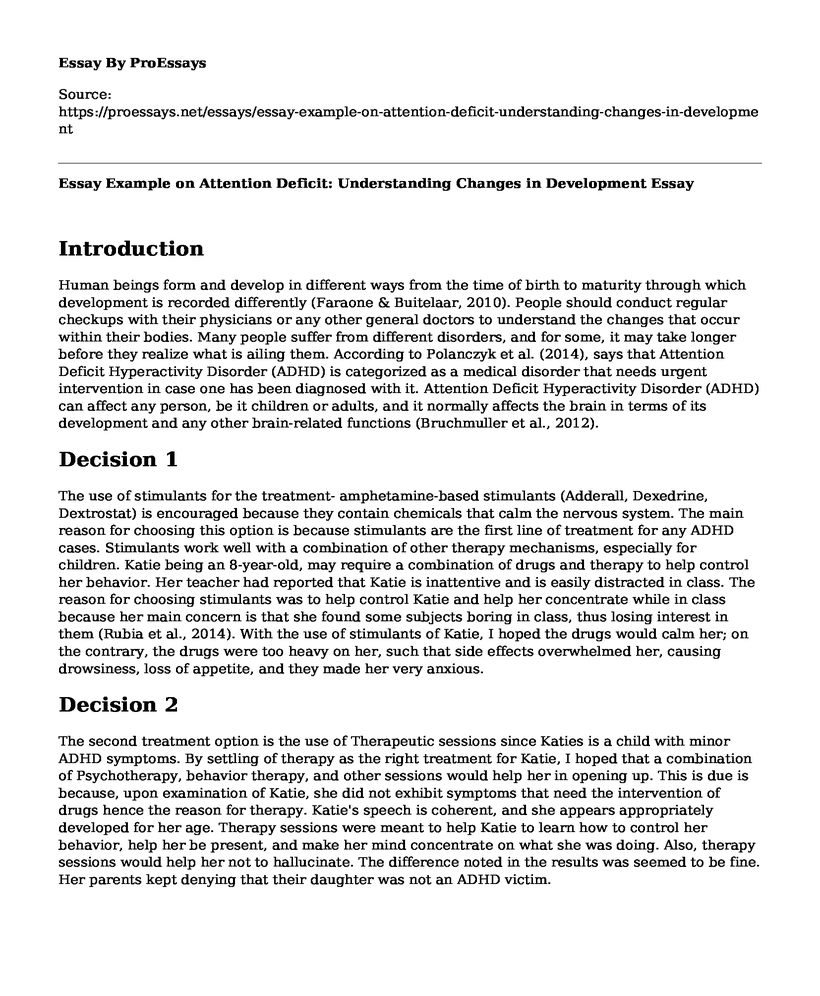Introduction
Human beings form and develop in different ways from the time of birth to maturity through which development is recorded differently (Faraone & Buitelaar, 2010). People should conduct regular checkups with their physicians or any other general doctors to understand the changes that occur within their bodies. Many people suffer from different disorders, and for some, it may take longer before they realize what is ailing them. According to Polanczyk et al. (2014), says that Attention Deficit Hyperactivity Disorder (ADHD) is categorized as a medical disorder that needs urgent intervention in case one has been diagnosed with it. Attention Deficit Hyperactivity Disorder (ADHD) can affect any person, be it children or adults, and it normally affects the brain in terms of its development and any other brain-related functions (Bruchmuller et al., 2012).
Decision 1
The use of stimulants for the treatment- amphetamine-based stimulants (Adderall, Dexedrine, Dextrostat) is encouraged because they contain chemicals that calm the nervous system. The main reason for choosing this option is because stimulants are the first line of treatment for any ADHD cases. Stimulants work well with a combination of other therapy mechanisms, especially for children. Katie being an 8-year-old, may require a combination of drugs and therapy to help control her behavior. Her teacher had reported that Katie is inattentive and is easily distracted in class. The reason for choosing stimulants was to help control Katie and help her concentrate while in class because her main concern is that she found some subjects boring in class, thus losing interest in them (Rubia et al., 2014). With the use of stimulants of Katie, I hoped the drugs would calm her; on the contrary, the drugs were too heavy on her, such that side effects overwhelmed her, causing drowsiness, loss of appetite, and they made her very anxious.
Decision 2
The second treatment option is the use of Therapeutic sessions since Katies is a child with minor ADHD symptoms. By settling of therapy as the right treatment for Katie, I hoped that a combination of Psychotherapy, behavior therapy, and other sessions would help her in opening up. This is due is because, upon examination of Katie, she did not exhibit symptoms that need the intervention of drugs hence the reason for therapy. Katie's speech is coherent, and she appears appropriately developed for her age. Therapy sessions were meant to help Katie to learn how to control her behavior, help her be present, and make her mind concentrate on what she was doing. Also, therapy sessions would help her not to hallucinate. The difference noted in the results was seemed to be fine. Her parents kept denying that their daughter was not an ADHD victim.
Decision 3
The next option was to her Katie's parents seek a further examination from another specialist, preferably a children's expert. The reason was to help the parents get another specialist's point of view then cross-examine the first results and the second ones since they seemed anxious and annoyed why we insisted that their daughter was not ADHD. The test results were different from the initial tests done on Katie. She did not exhibit any signs of hallucinations, her attention seamed intact, and she was even able to count numbers backward from 100s by serial 2s and 5s. Contrary to what the initial cross-examination report was, Katie exhibits a normal person child's behavior.
Conclusion
In a nutshell, the development of human beings takes place in different ways. People need to conduct regular checkups with their doctors to understand any changes occurring within their bodies. As it is currently, people are suffering from many disorders that, if checkups are done in time, can be diagnosed. Attention Deficit Hyperactivity Disorder (ADHD) is just one of the many mental disorders currently affecting young people. It is known to affect brain ability and other brain-related activities but is curable with remedies like stimulants, therapy amongst other ways.
References
Bruchmuller, K., Margraf, J., & Schneider, S. (2012). Is ADHD diagnosed in accordance with diagnostic criteria? Overdiagnosis and influence of client gender on diagnosis. Journal of consulting and clinical psychology, 80(1), 128.
Faraone, S. V., & Buitelaar, J. (2010). Comparing the efficacy of stimulants for ADHD in children and adolescents using meta-analysis. European child & adolescent psychiatry, 19(4), 353-364.
Polanczyk, G. V., Willcutt, E. G., Salum, G. A., Kieling, C., & Rohde, L. A. (2014). ADHD prevalence estimates across three decades: an updated systematic review and meta-regression analysis. International journal of epidemiology, 43(2), 434-442.
Rubia, K., Alegria, A. A., Cubillo, A. I., Smith, A. B., Brammer, M. J., &Radua, J. (2014). Effects of stimulants on brain function in attention-deficit/hyperactivity disorder: a systematic review and meta-analysis. Biological psychiatry, 76(8), 616-628.
Cite this page
Essay Example on Attention Deficit: Understanding Changes in Development. (2023, May 30). Retrieved from https://proessays.net/essays/essay-example-on-attention-deficit-understanding-changes-in-development
If you are the original author of this essay and no longer wish to have it published on the ProEssays website, please click below to request its removal:
- Society Killed the Teenager Essay Example
- Essay Example on a College Student's Struggle With Early Risers
- Diagnosing Autism Spectrum Disorder: Clinical Lengths - Essay Sample
- Essay on Nurse Qualification Impact: Burnout & Career Change?
- Essay Example on Media Representation of Mental Illness: A 21st Century Challenge
- Eating Disorders: Anorexia, Bulimia, Binge Eating & Body Dysmorphic Disorder - Essay Sample
- Paper Example on Compulsory Admission of Psychiatric Patients: Systematic Sampling Study







